What is a basketball screen
A basketball screen is a fundamental skill and action that occurs when at least one offensive player attempts to block or delay a defender, primarily to create space as well as separation for another offensive player who could use the screen to get open for scoring or playmaking opportunities.
What is an off-ball screen
An off-ball screen is a basketball screen set by a screener on a defender that is not directly guarding the ball.
For example, if a player with the ball is on the right side wing, then an off-ball screen would occur anywhere else on the court such as the top, the low post, or the corner.
Some common types of off-ball screens include the back screen, cross screen, down screen, and the stagger screen to name a few.
Additionally, some off-ball screens such as the cross screen can create scoring opportunities for players near the basket while other off-ball screens such as the down screen can create open jump shots for perimeter players.
What is an on-ball screen
An on-ball screen, also known as a pick or ball screen, is a basketball screen set on a defender that is directly guarding the ball.
Some common types of on-ball screens include the flat ball screen, the side screen, the step-up screen, and the drag screen to name a few.
Additionally, these types of basketball screens are typically used in pick and roll or pick and pop situations to create offensive scoring opportunities.
What is the difference between a pick and a screen
Technically speaking, there is no difference between the two. However, the term pick, is generally used when referring to an on-ball screen while the term screen, could refer to either the off-ball screen or the on-ball screen.
How to set a basketball screen
To set a basketball screen, a player will position their feet about shoulder-width apart with their back straightened and knees slightly bent to form a good base.
Additionally, players will put their hands across their chest or across their lap and have their elbows kept within their own cylinder, also referred to as a vertical plane.
In other words, a player’s elbows should not extend beyond their own sides. Also, players could use an open hand or closed fist when placing their hands across their body.
What is the importance of setting screens
Setting screens are an important concept within basketball offense because without them, it would be easier for the defense to limit the efficiency of the offense and at the same time, it would be more challenging for the offense to score effectively against the defense.
Additionally, as mentioned earlier, screens could be used to create space and separation which then could generate opportunities to score.
What is an illegal basketball screen
An illegal screen generally occurs when an offensive player setting a screen does not stay within their own cylinder or the offensive player setting the screen does not allow a defender, who would be the target of the screen, enough time and/or distance to avoid the screen.
Furthermore, in the case of an on-ball screen, if the player in possession of the basketball dribbles toward the screener and the defender makes contact with the screen before the screener is able to fully establish a stationary stance with feet clearly planted on the floor, then that is also technically an illegal screen.
Moreover, in the case of an off-ball screen, if the defender attempts to quickly avoid the screen prior to the moment of contact, then the screener could move to re-establish the screen as long as the movement occurs before the moment of contact.
This type of movement typically occurs during the stagger screen action that occurs when the defender avoids the first screener but gets blocked or delayed by the second screener who re-established the screen before the moment of contact.
However, according to Rule 10, Section XIV of the Official NBA Rule Book, a screener cannot step out of bounds to set a screen on a defender, particularly on the baseline in the frontcourt.
For example, if a screener is setting a pin down screen near the baseline but the defender attempts to avoid the screen by stepping out of bounds, then the screener cannot also step out of bounds to re-establish the screen, even if the screen occurs before the moment of contact. In that instance, it would be considered a violation.
It should also be noted that according to NFHS Rule 4, Section 40, Art. 8; a defender cannot use any body parts such as the hands, arms, or shoulders to intentionally run through a screen or force their way through the screen.
In addition to that, the defender cannot hold the screener to push or pull that screener out of the way to guard the respective assignment. If that occurs, then the defender would more than likely be called for a foul by one of the referees.
How to signal for a basketball screen
To call or signal for a screen, the ball handler will typically use a raised fist or use some other type of visual cue to let a screener know that they would like to receive an on-ball screen.
Likewise, in some instances, a screener could also use a raised fist or other visual cue to inform the ball handler (in the case of an on-ball screen) or other teammates (in the case of an off-ball screen) that the screener is getting ready to set a screen for them.
How to defend against on-ball or off-ball screens
There are various ways to defend against on-ball or off-ball screens with defensive techniques such as going over the screen, going under the screen, or implementing defensive switches to mitigate or completely stop the effectiveness of the on-ball or off-ball screens.
For example, in reference to the on-ball screen, if the offensive ball handler has speed, quickness, and the ability to shoot from three-point range, it would probably be best to fight through the screen and execute the soft hedge or hard hedge technique with the screener’s defender.
On the other hand, if the ball handler and/or the screener are not good shooters or the screener’s defender does not have quick feet, then going under the screen and/or executing the drop coverage with the screener’s defender could be a more feasible strategy.
As another example, in reference to the off-ball screen, if a player receives a UCLA screen while cutting to the basket, then the defender guarding the screen receiver might be able to limit the effectiveness of the screen by jumping to the ball and cutting over the screen with a hand in the passing lane.
As an additional example, if a player receives a down screen while cutting towards the perimeter, then the defender could go under the screen to close-out on the player who received the down screen and take away the potential open jump shot opportunity. Ultimately, the types of on-ball or off-ball screening defensive methods would generally depend on the capabilities of the offense as well as the defense.
What are the types of basketball screens
This is a list of the different types of basketball screens that could be used within any basketball offense to create scoring opportunities.
Back Screen
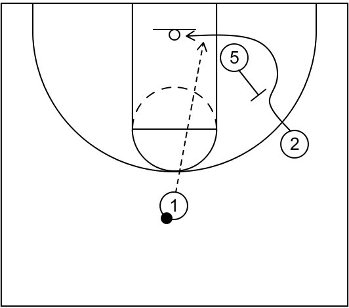
The back screen, sometimes referred to as a rip screen, consists of basketball action that occurs when one offensive player is able to set a screen behind a defender that is guarding a second offensive player and after that, the second offensive player could then use that screen to get open, particularly near the basket, for a potential scoring opportunity.
For the example above, 2 cuts to the basket via the back screen of 5. After that, 2 receives the ball from 1 and scores near the rim.
Corner Ball Screen

A corner ball screen occurs when an offensive player receives an on-ball screen near the left side or right side corners of the court. On the diagram example, 2 dribbles toward the basket by way of the corner ball screen set by 4.
Cross Screen
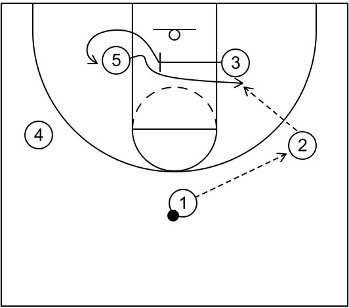
The cross screen is usually set near the middle of the lane in front of the basket or sometimes near the high post free throw line area.
This type of screen is typically implemented to create scoring opportunities for low post players.
In addition to that, if a smaller player such as a guard were to set a cross screen for a bigger player such as a center, then a potential mismatch could be created if the defenders switch assignments.
Also, if the smaller player that set the initial cross screen were to receive a down screen via screen the screener action, then that could lead to a possible perimeter scoring opportunity as well.
On the diagram example, 2 receives the ball from 1 and as that happens, 5 cuts to the right side low post block via the cross screen set by 3.
Additionally, 3 fills the vacated left side low post block as well. Next, 5 receives the ball from 2 and can score near the basket with a low post move.
Double Ball Screen

The double ball screen occurs when the ball handler receives two consecutive on-ball screens, usually at the top or near the wings.
On the diagram example, 1 dribbles toward the basket by way of the two double ball screens set by 4 and 5. Additionally, 5 rolls to the rim and 4 pops out to the top.
Down Screen
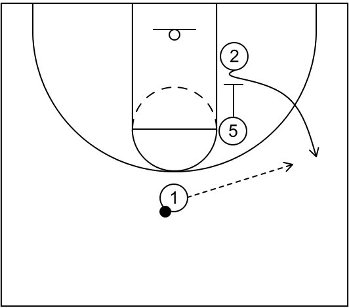
The down screen occurs when one offensive player sets a screen facing the general direction of the baseline and a second offensive player uses the screen to get open, typically towards the perimeter.
On the diagram example, 2 cuts to the right side wing area via the down screen set by 5. After that, 2 receives the ball from 1 and then takes the open jump shot.
Pin Down Screen

The pin down screen is a variation of the standard down screen and it occurs near the basket and/or baseline. Additionally, the pin down screen is typically utilized in relation to floppy action, which consists of a single screen on one side of the lane and a double screen on the other side.
On the diagram example, 2 cuts to the right side wing via the pin down screen set by 5. Afterwards, 2 receives the ball from 1 and takes the open jump shot.
Wide Pin Down Screen
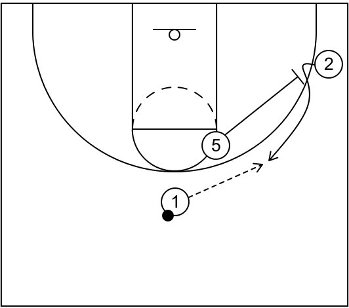
The wide pin down screen, occasionally referred to as a corner pin down screen, is a variation of the standard down screen. However, in this variation, the screener sets an angled screen for a teammate that is generally positioned near a corner.
On the diagram example, 2 cuts to the right side wing area via the wide pin down screen set by 5. Following that, 2 receives the ball from 1 and can take the open jump shot.
Drag Screen
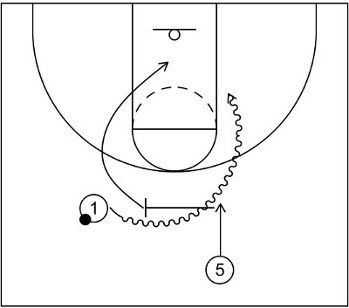
A drag screen typically occurs during transition offense in which the ball handler receives the on-ball screen to create scoring opportunities near the basket or from the perimeter.
On the diagram example, 1 dribbles toward the right side wing via the drag screen set by 5 who also rolls to the basket.
Following that, 1 could take the open jump shot or 5 could receive the ball from 1 and score near the rim.
Elevator Screen
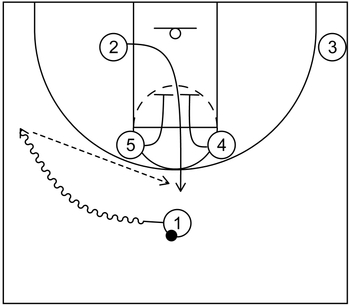
The elevator screen occurs when two screens are set parallel to each other with a small gap.
Afterwards, another offensive player will cut in between the gap of the screens and then the two screeners will close the gap to block a defender.
On the diagram example, 1 dribbles toward the left side wing area. Next, 2 cuts to the top by way of elevator screens set by 4 and 5. Afterwards, 2 receives the ball from 1 and then takes the open jump shot.
Flare Screen

A flare screen occurs when a player receives a screen while cutting away from the ball with the intended objective of creating separation for a potential open jump shot near the perimeter or another type of playmaking opportunity.
On the diagram example, 2 cuts over the top towards the left side wing area by way of the flare screen set by 4. After that, 2 receives the skip pass from 1 and then takes the open mid-range jump shot.
Flex Screen

The flex screen consists of action that occurs when an offensive player cuts toward the general area between a low post block and the adjacent corner while facing the sideline to set a screen for a second offensive player near that same corner.
Additionally, this type of basketball screen is a fundamental element within the offensive strategy known as the flex offense but it can also be used in various set plays, motion-based offenses and/or continuity offenses.
On the diagram example, 4 receives the ball from 1 and following that, 3 receives it from 4. As that action happens, 2 cuts to the basket via the flex screen set by 5, receives the ball from 3, and then scores at the basket.
Hammer Screen
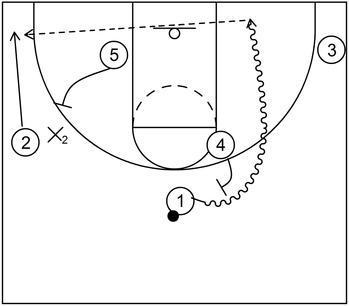
The hammer screen is derived from the hammer set play and it features screening action that occurs on the weak side, which could then potentially create an open three-point shot for the team’s best shooter.
On the diagram example, 1 dribbles toward the basket by way of the on-ball screen set by 4.
As that happens, 2 cuts to the left side corner via the hammer screen set by 5. Afterwards, 2 receives the ball from 1 and could take the open three-point shot.
High Screen
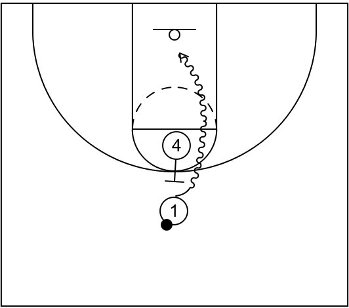
The high screen, also known as the mid-screen or flat ball screen, is typically set near the middle of the court and it can be thought of as an on-ball variation of a back screen.
On the diagram example, 1 dribbles to the basket via the high screen set by 4.
Pick and Roll
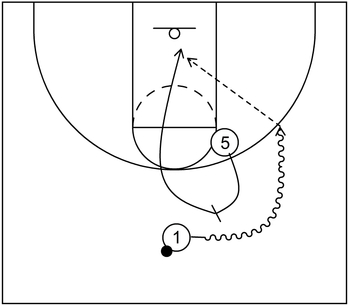
The pick and roll action occurs when the ball handler receives an on-ball screen (also known as the pick) and immediately following that, the screener rolls to the basket.
This screening action is probably one of the most common actions utilized from youth basketball up to the professional levels.
On the diagram example, 1 dribbles toward the right side wing via the pick set by 5. Afterwards, 5 rolls to the rim, receives the ball from 1, and then scores with a layup or dunk.
Spain Pick and Roll
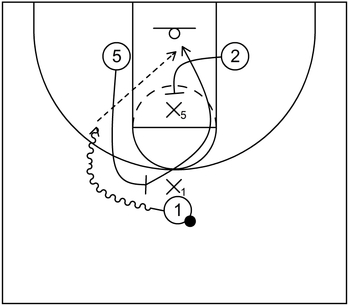
Spain pick and roll occurs when a player sets an on-ball screen and after that, the same player rolls to the basket via a back screen from another teammate.
Also, the player who sets the on-ball screen is usually a post player that rolls to the basket while the player setting the back screen is typically a guard or other type of perimeter player.
On the diagram example, 1 dribbles toward the left side of the court via the on-ball screen set by 5 who also rolls to the basket.
As that ball screen action happens, X5 stays back in the drop coverage to take away the effectiveness of the roll by 5.
However, X5 gets caught on the back screen set by 2. After that, 5 could receive the ball from 1 and score around the basket.
Pick and Pop
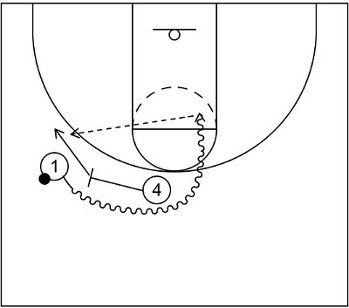
The pick and pop action occurs when the ball handler receives an on-ball screen and after that, the screener pops to a specified spot on the perimeter such as the wing.
On the diagram example, 1 dribbles towards the basket via the on-ball screen set by 4. Following that, 4 pops out to the left side wing, receives the ball from 1, and can take the open jump shot.
Ram Screen

The ram screen is a special type of basketball screen in which a player on offense receives an off-ball screen from a teammate before setting an on-ball screen for another teammate.
Additionally, the ram screen could be implemented to make the hedge defensive tactic less effective because the defender of the offensive player receiving the off-ball screen would have to fight through that screen which could become a problem if that same defender planned to hedge the ball screen action.
Furthermore, if the off-ball screener’s defender could not fight through the screen or the defense executes a switch, then this could lead to an advantage for the offense such as a mismatch or potential open jump shot.
On the diagram example, 5 cuts to the top via the down screen set by 2, which is also the ram screen. Afterwards, 1 dribbles toward the high post area via the on-ball screen set by 5 while 2 fills the left side corner.
Following that, 5 could receive the ball from 1 and score near the basket. Also, as an alternative option, 1 could simply take the mid-range jump shot if open.
Related: Secrets To The Pick And Roll: The Ram Screen – YouTube
Screen the Screener
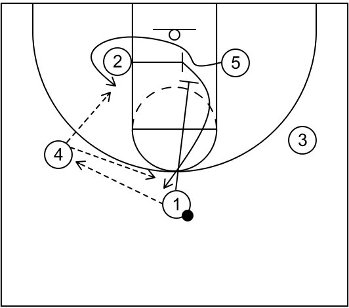
Screen the screener action occurs when one particular player cuts to a certain area of the court to set an initial screen for a secondary player and after that, the initial screener attempts to get open by way of an additional screen.
On the diagram example, 4 receives the ball from 1 and after that, 5 cuts to the left side low post block via a cross screen set by 2.
Next, screen the screener action occurs when 2 cuts to the top by way of a down screen set by 1.
Afterwards, 5 could receive the ball from 4 and then score with a low post move or 2 could receive the ball from 4 and take the open three-point jump shot.
Shuffle Screen

The shuffle screen occurs near the high post when a perimeter player known as the first cutter executes a shuffle cut to the basket after another player known as the feeder receives the ball at the opposite wing.
On the diagram example, 1 cuts to the basket via a shuffle screen set by 5, receives the ball from 3, and then scores near the rim.
Side Ball Screen
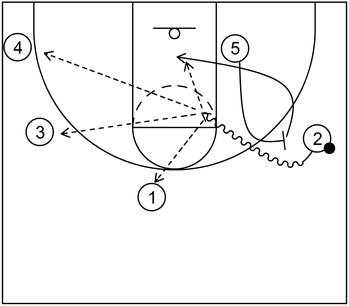
The side ball screen occurs when the ball handler receives an on-ball screen near the sideline.
On the diagram example, 2 dribbles toward the middle of the lane via the side ball screen set by 5. Afterwards, 2 could take the mid-range jump shot if open or pass the ball to other teammates for possible scoring opportunities.
Slip Screen
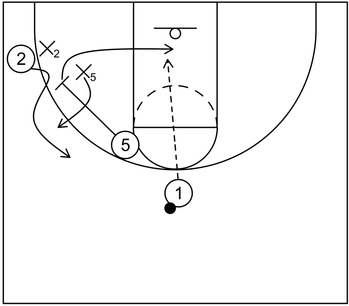
The slip screen occurs when a player is in the process of setting a screen, but quickly cuts to the basket during the moment of time when the screen receiver has the opportunity to use the screen.
On the diagram example, 2 cuts to the wing via the wide pin down screen set by 5. However, X5 decides to execute a defensive switch to take away the potential open jump shot from 2.
Once that happens, 5 could slip to the basket. From that point, X2 would be behind 5 and simply not have enough time to recover to properly contest. After that, 5 could receive the ball from 1 and score near the rim.
Stagger Screen
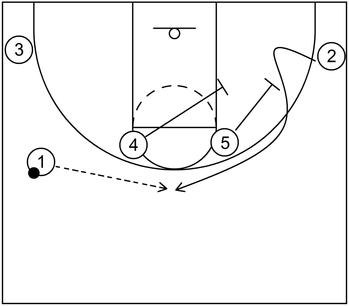
The stagger screen occurs when an offensive player cuts from one area of the court to another area via consecutive screens that are set by two additional offensive players.
On the diagram example, 2 cuts to the top by way of the stagger screen set by 4 and 5. After that, 2 receives the ball from 1 and takes the open three-point jump shot.
Step-Up Screen
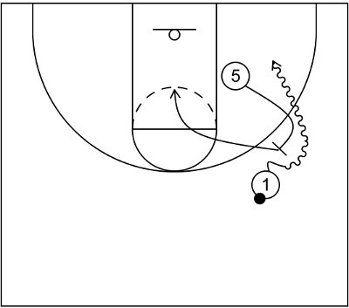
The step-up screen is a special type of on-ball screen that is usually set near the slot or wing areas with the screener facing away from the adjacent baseline.
On the diagram example, 1 dribbles toward the baseline via the step-up screen set by 5. Following that, 5 could roll towards the basket and receive the ball from 1 if that is open.
UCLA Screen
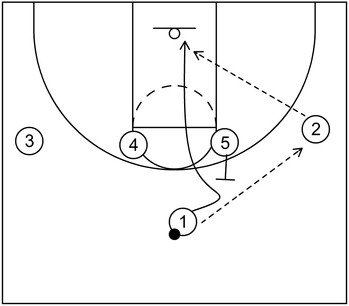
The UCLA screen features a back screen set by a player positioned near the high post elbow on the ball side of the court.
On the diagram example, 2 receives the ball from 1 and after that, 1 cuts to the basket via the UCLA screen set by 5. Next, 1 receives the ball from 2 and scores near the basket.
Twist Screen
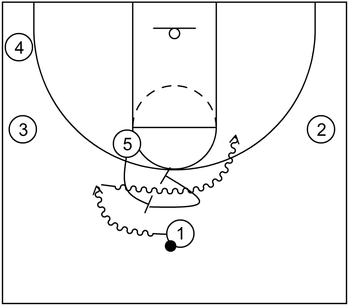
The twist screen occurs when the ball handler receives a screen towards one side of the court but then receives a re-screen towards the opposite side of the floor.
The twist screen could be used as a counter to the on-ball defender going over the top or under the screen.
On the diagram example, 1 dribbles toward the left side via the screen set by 5. However, immediately afterwards, 1 dribbles back towards the opposite side of the floor with misdirection and receives a re-screen from 5.
Horns Twist
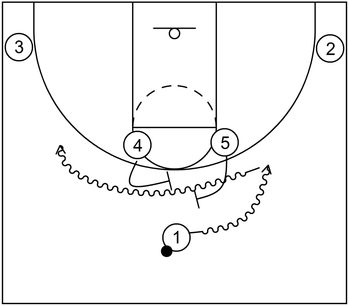
Horns Twist is somewhat similar to the twist screen. However, with this variation, the ball handler comes off a screen from one high post screener but then executes misdirection to receive another ball screen from the opposite high post screener.
Horns Twist could be useful against defenders that go over or under the initial screen and it could also be particularly effective as a counter to teams that implement a switching defense tactic.
On the diagram example, 1 initially dribbles toward the right side wing via the on-ball screen set by 5. Following that, 1 dribbles back to the top and then towards the left side wing by way of the on-ball screen set by 4.
Related: Horns Twist – YouTube
Brush Screen
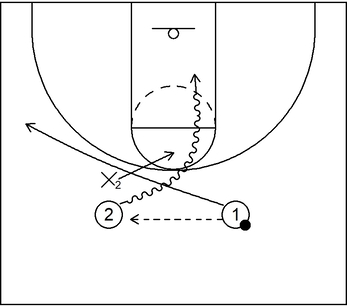
The brush screen, sometimes referred to as a blur screen or brush cut, consists of action that occurs when one offensive player moves toward the direction of a second offensive player and immediately afterwards, the second offensive player moves underneath the first.
Once that action happens, the defender of the first offensive player could inadvertently brush against the defender of the second offensive player or the defender of the second offensive player could inadvertently brush against the first offensive player.
In either case, the movement of one or both defenders could become delayed, which could lead to an offensive advantage in reference to creating separation.
On the diagram, 2 receives the ball from 1 and afterwards, 1 immediately cuts toward the left side wing.
However, as that happens, 2 begins to dribble towards the basket as 1 cuts in front of them.
From there, if the timing is good, then X2 would be delayed by the brush screen action of 1.
In other words, as X2 begins to slide their feet laterally to stay in front of 2, that defensive movement could be delayed by the cut of 1.
Following that, 2 could score near the basket via a field goal attempt such as a layup or floater.
Ghost Screen

The ghost screen is a type of fake screen in which a player will slowly run towards a teammate as if to set an on-ball or off-ball screen, but then sprint towards another location on the court without actually setting the screen.
Also, the on-ball ghost screen could be used to create potential mismatches or double gap spacing on the court similar to the brush screen.
On the diagram example, 1 begins to dribble towards the right side wing and as that happens, 3 begins to slowly run towards 1 as if to set an on-ball screen.
However, 3 quickly sprints to the open space near the left side wing. Following that, 3 could receive the skip pass from 1 and then take the open three-point jump shot.
Related: Basketball Ghost Screen Ball Screen and Off the Ball Screen Plays – YouTube
What are examples of defensive actions against on-ball screens
These are diagram examples of how to defend against on-ball screens with defensive techniques such as going over/under the screen, drop coverage, ice defense, switching defenders, or utilizing trap defense to limit the effectiveness of the on-ball screen.
In addition to that, the screener’s defender could communicate with the on-ball defender by calling out the screen and saying something like “Drop”, “Ice”, “Switch”, or “Trap” to alert the on-ball defender of the proper defensive tactic.
Over the Screen
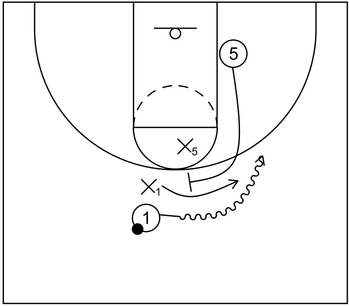
This is an example of on-ball screen defense in which the on-ball defender fights through a screen and goes over it to stick with the ball handler.
1 dribbles toward the right side wing via the on-ball screen set by 5. As that happens, X1 goes over the screen by briefly turning sideways and getting compact or “skinny” to fight through the screen.
Under the Screen
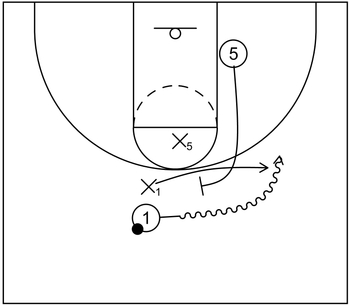
This is an example of on-ball screen defense in which the on-ball defender goes under a screen to meet the ball handler on the other side of the screening action.
1 dribbles toward the right side wing via the on-ball screen set by 5. As that occurs, X1 moves under the screen and cuts off any potential dribbling penetration by 1.
Hedge 1

This is an example of on-ball screen defense in which the screener’s defender successfully cuts off the dribbling pathway of the ball handler before recovering to the respective assignment.
1 dribbles toward the right side wing by way of the on-ball screen set by 5. Next, X5 quickly moves above the screener to execute the hedge action and cut off the dribbling path of 1 while X1 fights through the screen.
After that, 5 rolls to the basket but gets tagged by X4 while X5 recovers. As that happens, X3 also drops back a step to stand near the gap between 3 and 4, prepared to execute a close-out if a skip pass gets thrown to either offensive player.
Hedge 2
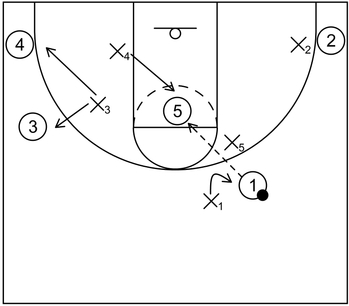
This is an example of on-ball screen defense in which the ball handler is able to throw a pocket pass to the screener before the screener’s defender is able to recover.
1 throws the pocket pass to 5 between X1 and X5. When that occurs, X4 tags 5 as before. However, now X3 will focus on splitting the difference between 3 and 4.
If 3 receives the ball from 5, then X3 can simply closeout on the ball while X4 and X5 recover to 4 and 5 respectively.
In similar fashion, if 4 receives the ball from 5, then X3 executes a closeout on 4 while X4 executes an X-out on 3. Additionally, X5 should have enough time to recover to 5 as well.
Related: X-out – The Basketball Dictionary
Drop Coverage
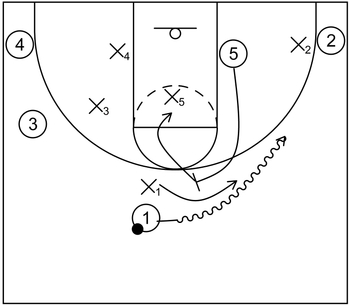
This is an example of the drop coverage in which the on-ball defender would go under the screen and the screener’s defender will drop back into the lane to take away the roll action of the screener.
This defensive technique is best suited against a screener who either always rolls to the basket and/or a screener who is not a good perimeter shooter.
In addition to that, the deep drop can be useful for screener defenders that are simply too slow to guard near the perimeter.
To start, 1 dribbles toward the right side wing via the ball screen set by 5. As that happens, X1 fights over the top of the screen while X5 drops back into the lane below the free throw line to limit the effectiveness of the roll action as well as to protect the basket.
Ice Defense
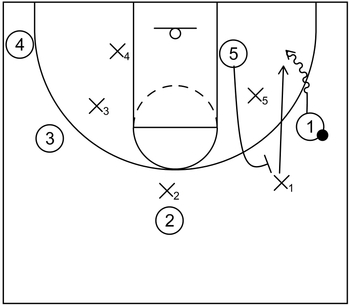
This is an example of the ice defense in which the on-ball defender would take away the path of the screen to force the ball handler towards the baseline.
Furthermore, this is also useful action to use if the screener and/or ball handler are not good perimeter shooters.
To start, 5 lifts up to set the side ball screen for 1. However, X1 steps into the path of the screen to push 1 towards the baseline area.
At the same time, X5 drops back below the screen to temporarily contain 1 until X1 is able to recover.
Additionally, if 5 rolls to the basket and the screening action, then X5 could simply recover back to 5.
Switching Defense
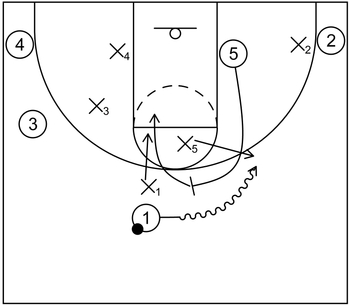
This is an example of the defensive switching in which the on-ball defender would switch assignments with the screener’s defender to limit the effectiveness of the pick and roll action.
The switching technique could be very useful when each defender can guard multiple positions.
To begin, 1 dribbles toward the right side wing by way of the on-ball screen set by 5. Following that, X5 picks up 1 while X1 drops down to cover 5. Additionally, as an alternative example, X4 could cover 5 while X1 sprints out to guard 4.
Trap Defense
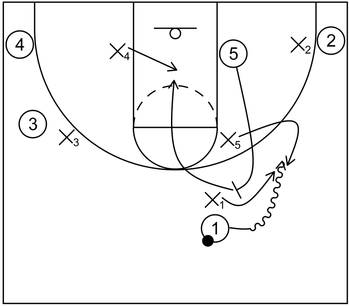
This is an example of the trap defense in which the on-ball defender and the screener’s defender would trap the ball handler to disrupt the flow of the offense or cause a turnover.
Additionally, when setting the trap, it is better to set it near the sideline which acts as another defender.
1 dribbles to the right side wing via the on-ball screen set by 5. As that happens, X1 fights over the top of the screen while X5 quickly hedges to take away the dribbling path of 1.
Next, X1 and X5 immediately trap the ball with high hands. At the same time, X4 tags 5 who rolls toward the basket. Also, X3 can step up to deny the reversal pass to 3 who would most likely cut towards the top as an passing option out of the trap for 1.
In most cases, X3 would actually drop back to split the difference between 3 and 4. However, in this instance, even if 1 is able to throw a skip pass to 4, it would be better to give up the lower percentage three-point shot to 4 than the higher percentage layup or low post move to 5.
Zone Defense

This is an example of 2-3 zone defense in which the offense attempts to screen the zone with the objective of creating scoring opportunities.
To start, 1 begins to dribble towards the middle via the on-ball screen set by 4. In standard man to man ball screen defense, the screener’s defender (which would be X4) would either hedge the screen or execute drop coverage.
However, with zone defense, no hedge action occurs because X4 covers a specified area near the back side of the zone.
Therefore, in this case, to limit the effectiveness of the ball screen action, X1 and X2 can execute certain actions based on the perimeter shooting ability of the ball handler.
If the ball handler is not a good three-point shooter, then X1 can simply go under the screen while X2 remains near the nail spot at the mid-line of the court.
Conversely, if the ball is a good three-point shooter, then X1 should fight over the top of the screen while X2 stunts at the ball handler before returning to the nail area, shown with the gray arrows.
Also, X2 should cover the gap on the stunt action so that 1 is not able to split between X1 and X2 as this could cause a potential breakdown in the zone.
Additionally, it is important that X2 only stunts at the ball and does not full commit to help because 1 could throw a skip pass to 3 and X4 probably won’t have time to closeout.
Furthermore, X3 probably would not have enough time to properly closeout to take away the open jump shot or dribble drive action of 3.